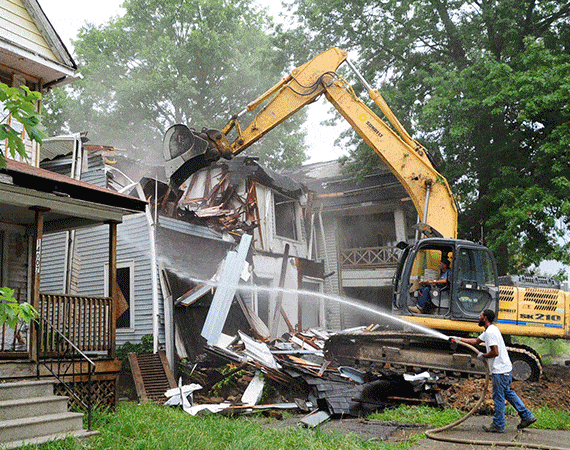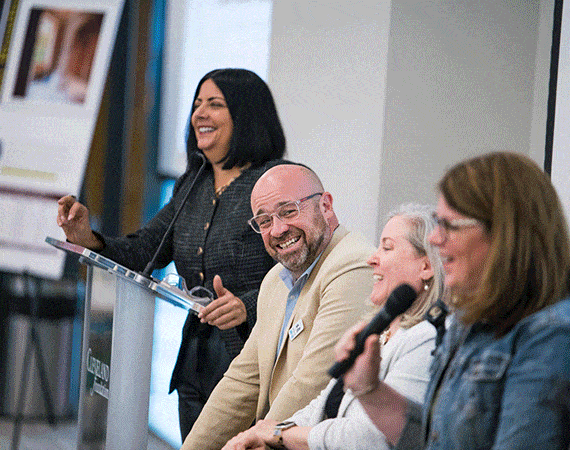Transforming Cuyahoga County communities one property at a time.

Our Mission
The mission of Cuyahoga Land Bank is to strategically return nonproductive
land to productive use to improve the quality of life for County
residents.
Our work catalyzes economic development in individual neighborhoods as well as throughout Cuyahoga County.
We work to advance the community’s broad policy goals within the prescribed parameters of the Ohio state statute that established county land banks. These goals include:
-
- Revitalization of neighborhoods
- Promotion of economic growth
- Creation of job and workforce development opportunities

Progress in every property.
01
Cuyahoga Land Bank has one unified mission to transform our community one parcel at a time.
10,000
Since 2009, Cuyahoga Land Bank has demolished more than 10,000 abandoned and blighted properties.
$3.6B
Cuyahoga Land Bank has generated more than $3.6 billion in economic impact as of 2024.
Our Principles
The Cuyahoga County Land Reutilization Corporation, also known as the Cuyahoga Land Bank, is a nonprofit corporation. We work to advance the community’s broad policy goals within the prescribed parameters of the State statute that established county land banks in Ohio. These goals include the revitalization of neighborhoods, the promotion of economic growth and the creation of job and workforce development opportunities.
Cuyahoga Land Bank is committed to healthy, sustainable community redevelopment within our County. We exhibit this by undertaking strategic blight clearance, appropriate and innovative reuse of vacant land and use of energy-efficient rehabilitation and new construction standards.
The Land Bank is uniquely empowered to help local governments foster effective land reuse. Put simply, the Land Bank has many of the same powers as traditional municipal land banks, yet as a nonprofit it is by design unhindered from bureaucratic impediments, enabling us to be efficient and strategic.
Through maximum collaboration with local governments, the Land Bank promotes and lifts the profile of individual community priorities. Our ability to work across political boundaries promotes regionalism and helps collectively leverage and focus precious resources on critical land reuse challenges.
The Land Bank’s Board of Directors promotes our mission, our purpose, and our autonomy. In accordance with State statute, the Board consists of nine members: the Cuyahoga County Executive (or designee); the Cuyahoga County Treasurer (or designee); a County Council appointment; two representatives from the county’s largest city, Cleveland; and four members selected unanimously by the County Executive, the County Treasurer and the County Council representative.
Cuyahoga Land Bank is an open and transparent organization with quarterly Board meetings that are open to the public. Our organizational documents, meeting agendas, resolutions and property inventory list are a matter of public record. The Cuyahoga Land Bank adheres to a Board-adopted ethics policy and files an annual public records report with the State of Ohio. Our annual audited financial statements, as accepted by the Ohio Auditor of State, are posted on our website.
The History of Cuyahoga Land Bank

The real estate crisis of 2008 brought widespread abandonment and neighborhood blight and plummeted home values. A collaborative group of minds—including then–Cuyahoga County Treasurer Jim Rokakis; former Land Bank President and General Counsel Gus Frangos; Senators Tim Grendel, Bob Spada, and chief legislative sponsor Tom Patton; State Representative Matt Dolan; select Cleveland Council Members; and members of the County’s nonprofit and academic community—set out to overcome these enormous obstacles.
Their efforts resulted in innovative approaches and policies and the formation of Cuyahoga Land Bank.
The Cuyahoga County Land Reutilization Corporation, also known as Cuyahoga Land Bank, is a nonprofit corporation. Cuyahoga Land Bank has been transforming our community, one parcel at a time, since 2009. Today, the Land Bank has demolished more than 10,000 abandoned and blighted properties and is the largest facilitator of home renovations throughout the County. Blighted commercial structures have been repurposed into economic development triumphs, public nuisance properties have been turned into community green spaces, and vacant lots have been turned into community gardens and side yards for homeowners.
Our efforts continue to place hundreds of formerly abandoned homes back onto the tax rolls and into the hands of proud new homeowners. We have also designed programs with our partners geared toward helping veterans, low- and moderate-income citizens, refugees and other underserved populations achieve the dream of living in safe, affordable housing. As of 2024, Cuyahoga Land Bank has generated more than $3.6 billion in economic impact.
Staff & Board
Cuyahoga Land Bank is led and staffed by a dedicated group of creative, technical, and professional team members who contribute to reshaping the destiny of our region.
The Board of Directors of Cuyahoga Land Bank is required to consist of nine members: the Cuyahoga County Executive (or designee); the Cuyahoga County Treasurer (or designee); a County Council appointment; two representatives from the county’s largest city, Cleveland; and four members selected unanimously by the County Executive, the County Treasurer and the County Council representative.
Need some help?
Cuyahoga Land Bank is a private, nonprofit, government-purposed entity formed in 2009 following the passage of Ohio Senate Bill 353, which granted county land banks the special community development powers needed to improve communities. The Land Bank’s mission is to strategically acquire properties, return them to productive use, reduce blight, increase property values, support community goals and improve the quality of life for County residents.
The primary sources of properties obtained by Cuyahoga Land Bank are:
- Tax foreclosures
- The State of Ohio forfeiture list
- Privately-foreclosed properties from banks and other lenders, such as Fannie Mae, Freddie Mac and HUD REO properties
- Housing Court referrals
- Occasional donations
When the Land Bank acquires a property, we assess it, taking into consideration the condition of electrical, plumbing, HVAC and structural systems including the roof, walls and foundation. Our evaluation of what to do with the property is based on this assessment as well as local input and other criteria. If we determine that a property could be rehabilitated, specifications are prepared, and, if deemed feasible, the property is either renovated by Cuyahoga Land Bank or made available for renovation by individuals or investors through our Deed-in-Escrow Program. Properties are scheduled for demolition if the assessment shows that they are deteriorated beyond the point of even considering rehabilitation, or if the cost to renovate based on the spec is deemed to be too high.
When the Land Bank acquires a property, we assess it, taking into consideration the condition of electrical, plumbing, HVAC and structural systems including the roof, walls and foundation. Our evaluation of what to do with the property is based on this assessment as well as local input and other criteria. If we determine that a property could be rehabilitated, specifications are prepared, and, if deemed feasible, the property is either renovated by Cuyahoga Land Bank or made available for renovation by individuals or investors through our Deed-in-Escrow Program. Properties are scheduled for demolition if the assessment shows that they are deteriorated beyond the point of even considering rehabilitation, or if the cost to renovate based on the spec is deemed to be too high. These properties then undergo an asbestos survey and any necessary remediation before demolition. Once a home is demolished, a neighbor can acquire the land to expand their side yard.
We offer several programs to purchase and renovate properties in our inventory. Our Deed-in-Escrow Program is the most popular, allowing qualified buyers—whether owner-occupants or investors—to buy and renovate Cuyahoga Land Bank properties. The Land Bank’s Real Estate Development team prepares professional renovation specifications (“the spec”). The buyer has approximately four months to complete renovations according to the spec after their offer is accepted. The deed to the property is held in escrow by the Land Bank until all renovations are complete and have passed a final inspection.
The purchase price for each parcel is unique. Select deed-in-escrow homes can be purchased for renovation for as low as $5,000 or less.
Our residential Side Yard Program offers vacant lots only to the adjacent neighbors on either side of our properties. Guidelines are occasionally waived or modified to accommodate unique circumstances.
Our property inventory changes frequently. You can search the list of available vacant lots we currently own or call (216) 698-8853 to ask about the availability of a particular lot. If you are interested in one of our vacant lots located on either side of your home, please call or email sideyard@cuyahogalandbank.org.
The Land Bank works with a diverse group of local contractors in undertaking our real estate development, demolition and vacant lot maintenance activities. We seek quality contractors that specialize in rehabilitation, new construction, board-up and security, debris removal, asbestos survey and abatement, demolition and landscaping and lawn maintenance. We also work with realty and title and appraisal professionals. If your company would like to be considered for work with Cuyahoga Land Bank, please click here to learn more about our application and pre-qualification form.
Cuyahoga Land Bank often collaborates with outside agencies, municipalities and community development organizations to achieve their redevelopment goals. We also partner with many mission-based organizations who serve at-risk populations in our community. Since 2014, the Land Bank has partnered with dozens of social service, faith-based and nonprofit organizations that offer affordable housing, community stabilization and skilled training opportunities to those most in need.